“We are living in a historical moment in Rioja. A time when we can do things on our own.” That’s how Conrado Herrero, senior export manager of Bodegas Queirón sums up what can be defined as the new, revamped Rioja where winemakers and producers across the region are trialling, experimenting and taking the region to a whole new level.
With so much pressure on their time it can be hard for busy and stressed sommeliers to even get to a trade tasting being held down the road – never mind invite them on a three day trip to Rioja.
But such is the appeal and importance of this still beguiling classic wine region that leading sommeliers jumped at the chance of being able to visit the area for themselves – some, despite their years of experience, for the first time.

Wherever you look in Rioja you are assured a stunning view of vines and the valley floor
But what did they expect to find? What did they want to discover? How could Rioja best present itself to them? Questions that were more than answered across a trip that covered all the main zones of the region and took in leading producers, tastings and masterclasses along the way.
An opportunity for Rioja to showcase the best of what it can do, and, crucially give leading sommeliers, representing a wide range of venues across the UK, the chance to see how and where its wines might fit in on their lists. What are the taste profiles, styles of wine and price points that can really make a difference in the premium on-trade?
To find out we invited the following sommeliers and restaurateurs to join the trip:
- Juliet Doughty, head sommelier, Elystan Street.
- Victoria Sharples, sommelier, restaurateur, wine consultant and owner Swains’ Wine Bar.
- Paul Belcher, owner, The Tapas Rooms.
- Johnny Murphy, sommelier, Noble Rot.
- Will Clarke, assistant head sommelier, The Pig Hotels.
- Ian Wharton, head sommelier, Scott’s Richmond.
Much to discover
What was immediately striking was just how much of Rioja’s potential was yet to be fully explored and understood by the travelling sommeliers. Particularly for those who had not had the chance to visit the region before.
For them it was the first opportunity to really get to grips with all the recent rule changes that have been made in the region to allow producers to make wines that better reflect the diversity of their soils. Best shown in the new ‘Vinos de Zona’ and ‘Vinos de Municipio’ category introduced to showcase the differences to be found in Rioja’s local and villages wines and ‘Viñedo Singular’ that has freed winemakers to make wines specific to their terroir.
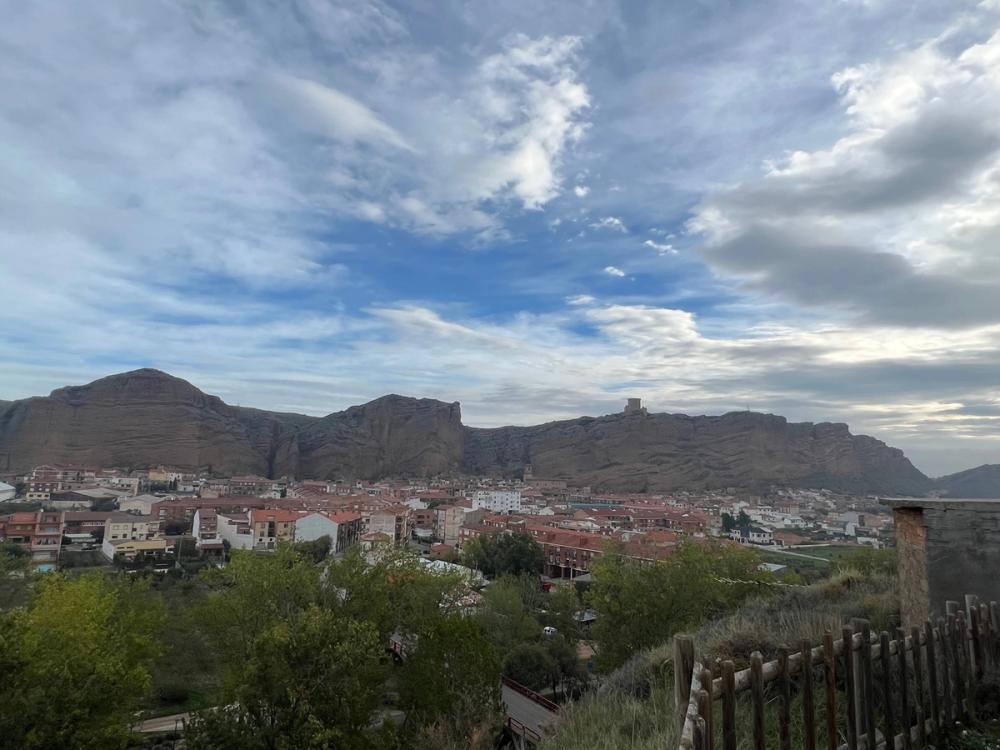
The sommeliers had the chance not visit all the sub zones of Rioja and were particularly taken by the traditional winemaking methods of Quel – Rioja’s oldest winemaking area
Moves that many Rioja producers and observers not only believe were long overdue, but mean its tapestry of wines can be better understood by where and how the wines are being made and not just by the traditional ageing categories of Crianza, Reserva and Gran Reserva.
But whilst the rule changes have been widely welcomed and embraced by the Rioja wine industry, it has introduced greater complexity to the region and, for example, for busy sommeliers to be, first, aware of and then, secondly, understand what they mean.
Which is what the sommelier trip was all about. Giving them a deep dive into the region and the chance to personally come to terms with what these changes might mean for them, their restaurants and what new styles of wine might be suitable for their lists.

Paul Belcher, owner and chef at The Tapas Rooms, was very much at home picking the right tapas bars to go to in Logroño – Rioja’s financial centre
Paul Belcher, who works with a lot of Rioja producers across his Tapas Rooms restaurants, said the region definitely still offers a “safety net” for his customers in terms of knowing what they are going to get. But he was keen also to help them “get out of that comfort zone” by seeing what new areas Rioja has to offer.
Historical moment
“We are living in a historical moment in Rioja. A time when we can Iive without the old rules of the region and do things on our own,” says Conrado Herrero, senior export manager at Bodegas Queirón run by the Pérez Cuevas family in Quel in Rioja Oriental.
“The big difference now is we are all focused on our terroir,” he adds. “We are looking to see what we can do better. We want to research and discover our wines in different ways using new methods.”
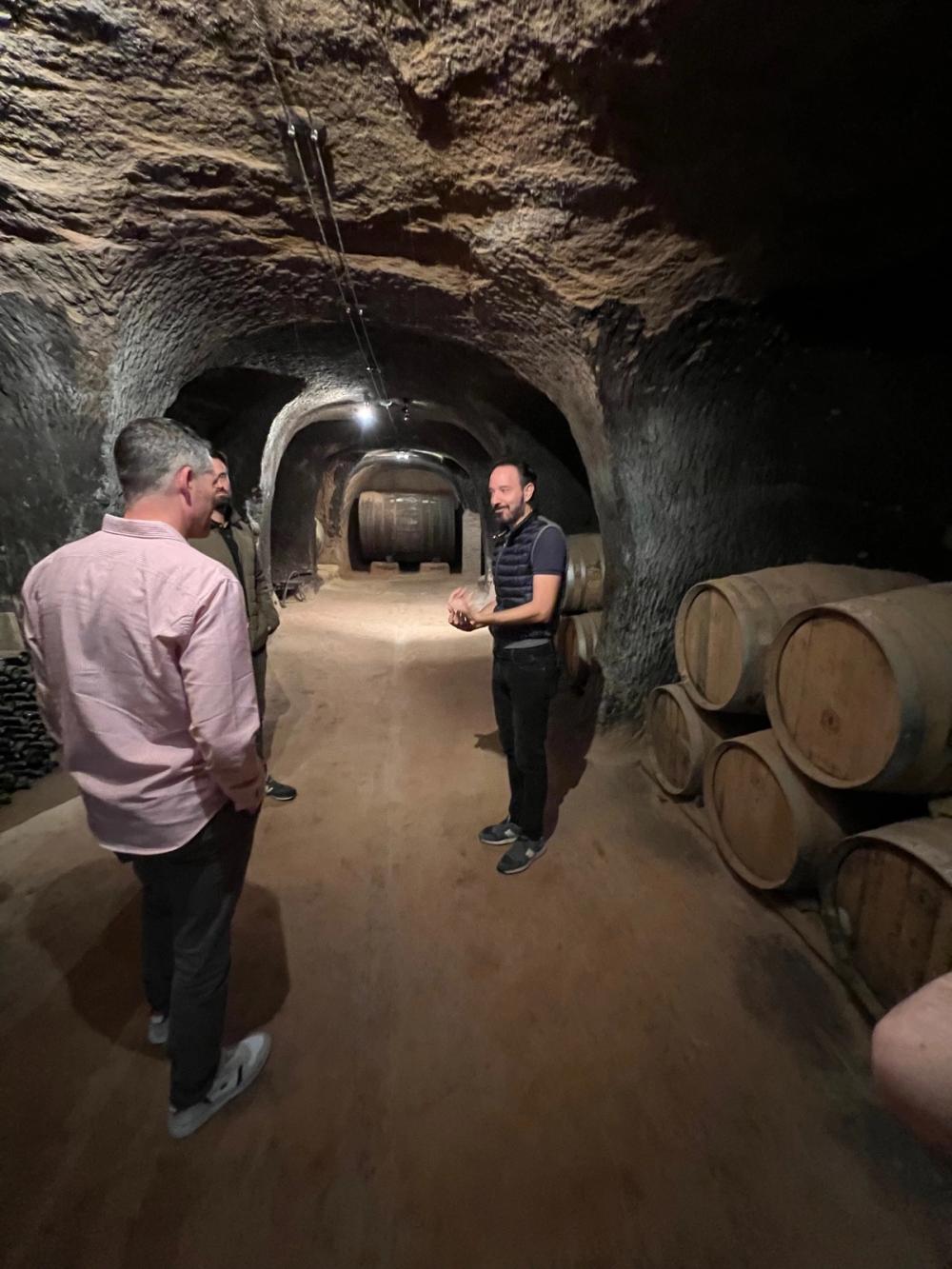
The sommeliers were able to visit the old traditional caves in Quel where so many producers started out and are still making wine in the area like at Bodegas Queirón
Bodegas Queirón, imported in the UK by Boutinot, is also a great example of a traditional producer, whose home is in the ultra traditional high altitude wine quarter of Barrio de Bodegas de Quel, dating back to the middle ages. But which has also invested in a modern winery and cellars, built into the side of a mountain, and is using century plus old vines and indigenous varieties – like Tempranillo Blanco – to make “ever more precise, specialised wines” and making the most of the new Municipio and Viñedo Singular categories.

The new modern winery from Bodegas Queirón that is built into the mountains of Barrio de Bodegas de Quel
Guillermo Contado, export manager, is quick to praise the role of the buying team at Boutinot in how they are working closely with Queirón to make the most of the winemaking changes. “They have helped us a lot,” he says.
The sommeliers had chance to visit the only urban winery Bodega y Viñedos Arizcuren (imported by Carte Blanche) in Logroño, the region’s biggest city, and another example of how fast the wine scene is changing in the region. “We don’t do any classic, traditional wines,” says winemaker, Javier Arizcuren, preferring to use his concrete tanks and amphora to make up to 30,000 bottles of Viñedo Singular wines.
New generation
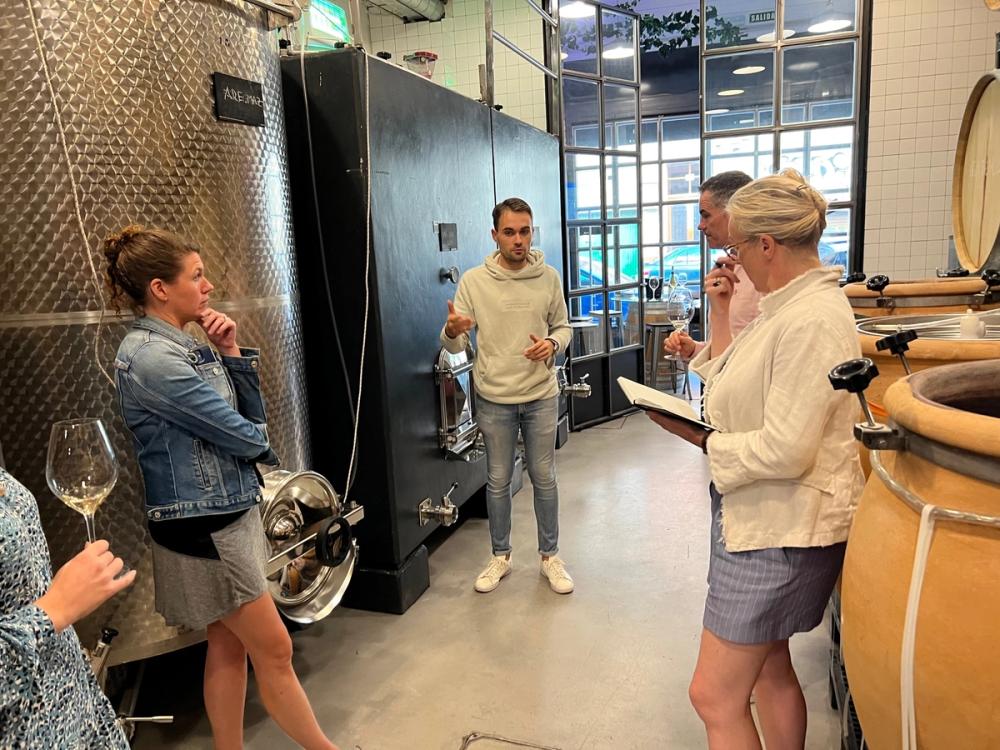
Bodega y Viñedos Arizcuren is the first and only urban craft winery operating in the centre of Logroño
He says it is the route that most of the younger generation of winemakers and producers in the region are taking since the rules were changed in 2017. “We want to show the diversity of Rioja and all its micro climates.”
Which is why he is keen to work with old vines and indigenous varieties where he can. Sourcing the best fruit from his family’s organic estate on the slopes of Mount Yerga. Like the blend of Garnacha, Mazuelo and Tempranillo from Quel in his Monte Gatún wine that comes from vines grown at an altitude of between 530 and 600m.
The sommeliers were particularly taken with his Apunte nº8 White wine made from 100% Viura and aged nine months in unlined claypots.
“We need to plant more of these varieties – like Graciano and Maturana – where we can and bring back varieties like Mazuelo. We need to explain Rioja in a different way,” says Arizcuren. “We need to tell our own story.”
He says there is also a growing collective spirit amongst the new generation of winemakers to “come together, taste together and share what is working and our knowledge”.
There is also a real energy for winemakers to travel to other regions and countries and see what inspiration they can bring back to Rioja. “To make good wine, you have to drink good wine and in the past it was probably a mistake to only drink wines from Rioja. You learn a lot when you travel.”
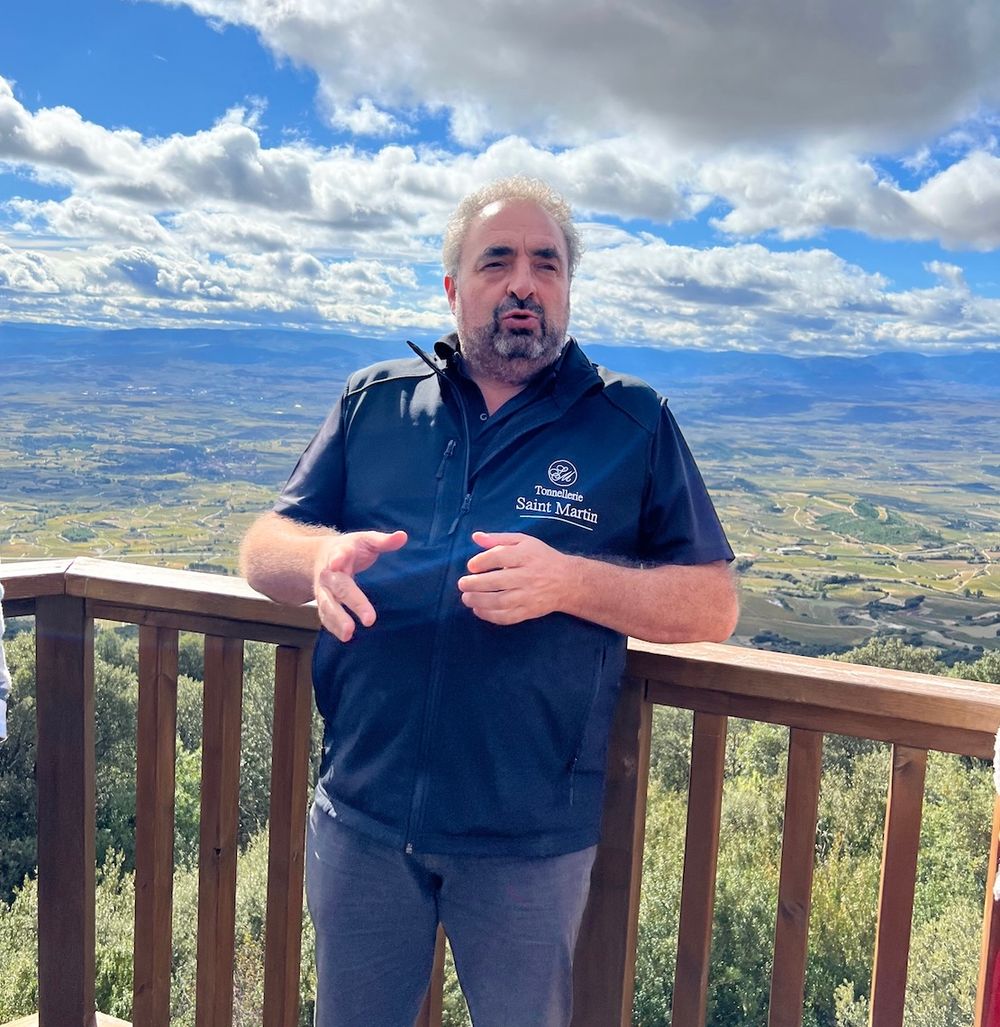
Gonzalo Sáenz de Samaniego, partner and winemaker at Bodegas Ostatu in Rioja Alavesa
With its 25,000 bottles a year production Bodegas Ostatu, in the heart of the valley of Rioja Alavesa, is a good example of a family business, started by Doroteo and María Asunción in the 1970s, that is making both classic aged Riojas, as well as its own Viñedo Singular wines. In all it takes grapes from 80 hectares of vines, 38 of which are its own and the rest own by members of its extended family, with a good combination of older and younger vines says, Gonzalo Sáenz de Samaniego, partner and winemaker.
Ainhoa Navaridas Zuneda, marketing and wine tourism manager, said it is good for the business to have both styles of wine – the traditional and the new Singular style – as the market is still not completely familiar with the new definitions, but the more personal, site specific, fruit focused wines are where more of the quality producers are moving to. “It’s a long term situation.”
Working with both traditional and modern styles certainly made sense to the sommeliers who similarly have to cater for all tastes in their restaurants. As Ian Wharton explained: “When you are pulling together a list, you have to cater for all tastes, and have to offer classic Riojas too.”
Which is why, added Will Clarke, it was nice for them “to taste and see these classic Riojas and what is being done with them”.
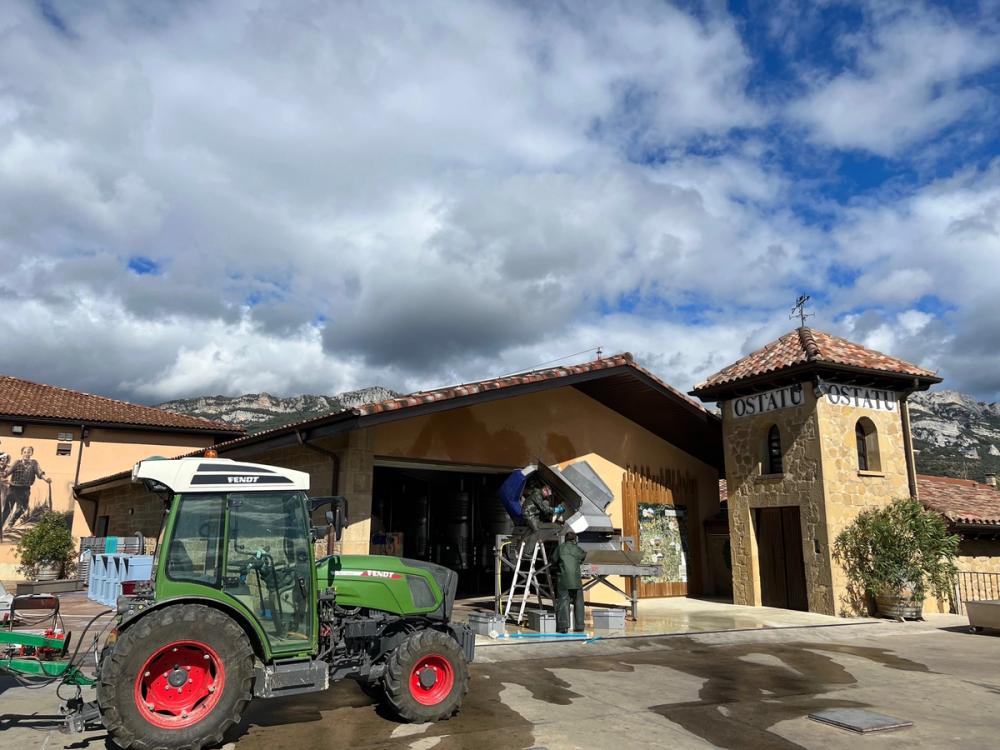
Bodegas Ostatu is one of a growing number of producers seriously expanding their white wine production
Bodegas Ostatu, which works with H2Vin in the UK, is also responding to market demand and looking to make more white wine which now accounts for 22% of its production. Sáenz de Samaniego said he “has learnt a lot about the ageing ability of white wines” and thinks they can age well for 15 to 20 years. “We are unusual in that we work with a lot of white grape varieties. We want to make gastronomic white wines.”
Johnny Murphy at Noble Rot was particularly taken by the Escobal wine made from 100% Tempranillo: “It’s got bright red fruits and is the style of Tempranillo I really like, it’s a lot more giving, more accessible.”
Which is very much the approach that Ostatu wants to take, said Sáenz de Samaniego. “We know drinkers are looking for fruitier wines and bottles they can drink now.” It is also experimenting with more natural, sulphur free wines as it feels the quality of its grapes can carry the wine far more on their own.
Doughty was particularly impressed by Ostatu’s range of wines: “I would put any on my list.”
Building on traditions
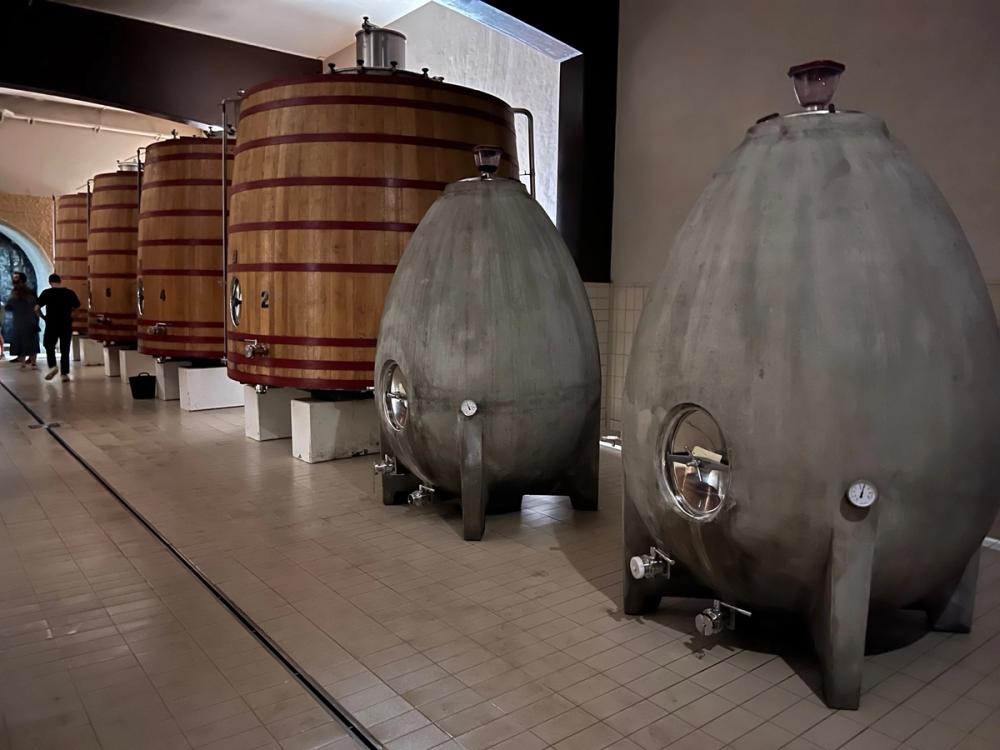
Throughout Rioja producers are now working with different formats to ferment and age wines including amphora and concrete eggs as well as traditional wood barrels
Whilst it is great to see all the dynamic changes taking place in Rioja, they are being made very much on the strong foundations of what is one of the oldest and traditional winemaking regions in the word. A history that gives Rioja its unique place in the world of wine.

You have to follow the ramparts of a castle to find the winery at Bodegas Castillo de Cuzcurrita
Where else, for example, can you visit a winery that is situated in the 14 century-built Cuzcurrita castle in the Rioja Alta? Which is where you can find Bodegas Castillo de Cuzcurrita, that only works with grapes picked from the local area. Here winemaker, Ana Martín Onzain, who has been with the business since it started in 2000, is in charge of producing 120,000 bottles of wines sourced only in Rioja Alta, including a number of single vineyard and village wines.
Wines that went down very well with the sommeliers, who, in particular, liked its own only white wine, Blanca del Castillo, made from old Viura vines at 650m altitude. “This is right up my street,” said Juliet Doughty. “A wine for a Christmas turkey that has weight but is lovely and fresh.” “My favourite white of the day. It’s really well made agreed,” said Will Clarke.

The sommeliers were particularly taken by the wines and winemaking talent of Ana Martín Onzain at Bodegas Castillo de Cuzcurrita
Its 100% Tempranillo Cerrado wine, that is only made in exceptional vintages, is a great example of what modern Rioja is all about, said Murphy. Using grapes only sourced within the walls of the castle it does not go through fining or stabilisation process before bottling.
The winery is also looking to make natural wines and work closely with restaurants in Spain, particularly Madrid and Barcelona to gain their confidence in what they are trying to do. “They are changing their attitudes towards these new styles of wine from Rioja. Which is good news for us,” said Ana Martín Onzain.
Doughty can see why: “I think they are amazing wines – restaurant and premium wine shop wines.”

The stunning entrance to Bodegas Bilbaínas
The sommeliers also had the chance to step into the history of Haro’s iconic Station Quarter and home for Bodegas Bilbaínas, whose Viña Pomal brand dates back to 1904, that has some of the biggest ((3,400m²) and oldest underground cellars in the region.
Bodegas Bilbaínas is one of the biggest producers in Haro, with 250 hectares of vineyards across the largely dry Rioja Alta helping to make 5 million bottles of wine a year, including sparkling brands Royal Carton and Lumen. Bilbaínas, under the stewardship of winemaker and director, Mayte Calve de la Banda, was the first winery in Haro to obtain Viñedo Singular certification and to produce Vinos Singulares from these vines.
“These are the wines you expect to see Rioja,” said Juliet Doughty. “Full of fruit and character.”
Big and powerful
Then there is the majesty and iconic status of Marqués de Riscal in Rioja with its world famous architecture at the San Vicente winery that has become such a feature of the Rioja landscape. So much so that it attracts over 120,000 visitors a wear for winery tours and to stay at its 50-plus bedroom, two restaurant hotel.
Even for seasoned wine professionals the sheer scale and ambition of Marqués de Riscal takes your breath away with endless cellars of barrels and that on average see its Crianzas age for between five to 15 years, its Reservas up to 40 years and its Gran Reservas staying in barrel for up to half a century. Its history might data back 160 years – and can claim to be the first Rioja wine to be bottled – but it is still at the pioneering end of the Rioja winemaking scene, and exports around 60% of its production to over 110 countries.
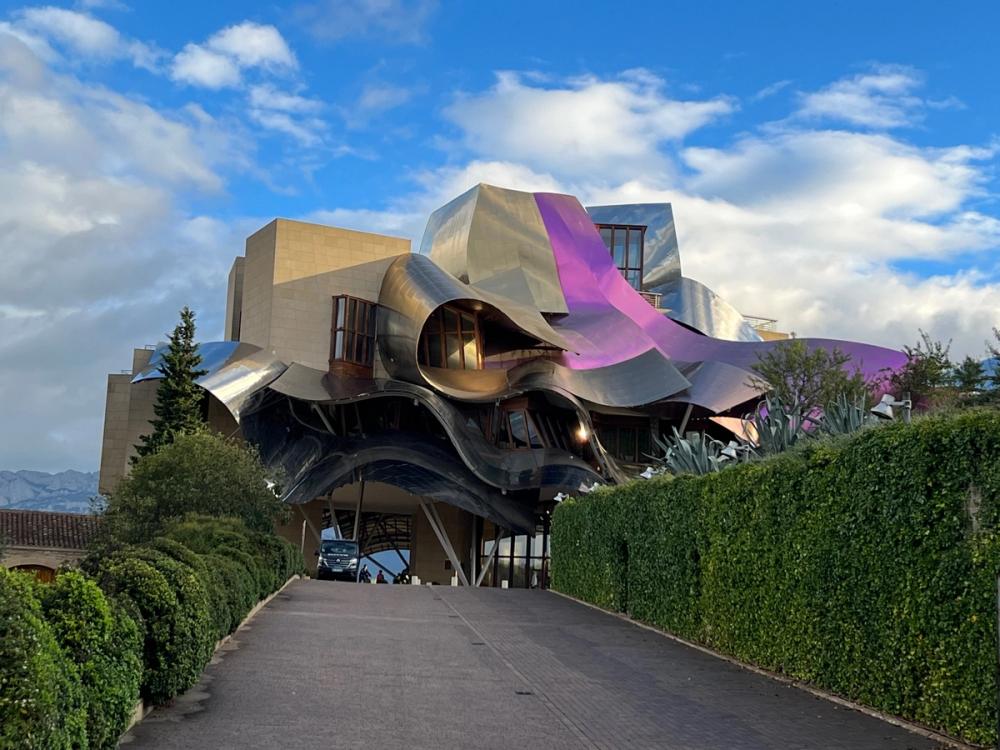
The one and only stunning architecture at Marques de Riscal
Marqués de Riscal manages 1,500 hectares of vineyards in Rioja, 500 of which it owns, the rest is then carefully secured from long term growers all within 12km of the winery.
The great skill of Marqués de Riscal is how it initially separates all its plots of vines, before bringing them together in an intricate blending process, said export manager, Javier Ybañez Creus. Somehow keeping track of what is slowly maturing away in its 37,000 barrels made up for French and American oak.
It has also embarked on a major grafting programme, and has now been able to graft over 300 hectares of vines, which it hopes will give it grape quality usually found in much older vines.
Doughty thought the “stand out” wine the sommeliers tasted was its “very expressive” XR Reserva, a blend of Graciano and Tempranillo. “It’s the perfect, classic Rioja. A kind of wine that would stand out in a blind tasting,” added Ian Wharton. “It’s also a style that a lot of people in Rioja are travelling in. It tastes more international. It’s very balanced. I love it.”
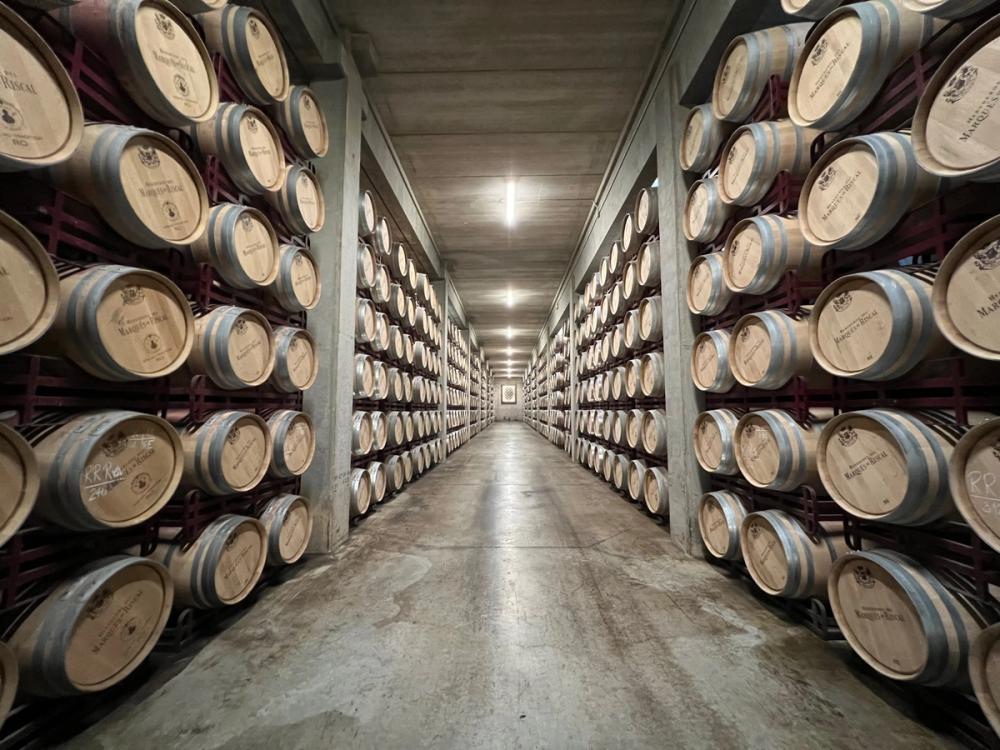
The sheer scale of Marques de Riscal and its cellar after cellar of ageing barrels – some 37,000 of them
Victoria Sharples picked up on the 2017 vintage of Gran Reserva which she said “is still a baby” in terms of ageing, but is already an “elegant, fresh and lovely wine”.
“That’s very much the concept of Marqués de Riscal, said Ybañez Creus. “We don’t want to make a 100 point wine that’s hard to finish your glass. We make wines to be enjoyed now with good company and that demands you pour another glass. That’s why we are selling our wines all over the world.”
Sharples said its Barón de Chirel reminds her more of a Super Tuscan than a wine made in Rioja. “It is very elegant.”
What the sommeliers thought
Johnny Murphy, sommelier, Noble Rot

Johnny Murphy was able to find some suitable reading on the trip
What perceptions of Rioja did you have before the trip?
I thought of Rioja as a classic wine region that produced wines of great quality and ageing potential. However, I also thought of it as a bulk wine region where a lot of medium to low quality wine is made.
What was your Rioja range before the trip?
We have a big selection of Rioja’s covering a wide range of price points starting at £28 through to £411 with a good number that sell well above £100.
What are your big takeaways from having been on the trip?
My biggest takeaway is the huge potential that Garnacha has in the region. The most inspiring wines I tasted where Garnacha-led blends from Arizcuren and Tentenublo. Technologically advanced and forward-thinking practises in the cellars seemed common. There is also the beginning of a shift in focus towards what formerly were minor blending varieties, both out of creativity and necessity in reaction to climate warming.
What surprised you most?
The extent to which every producer we visited, spoke about terroir. For some producers it felt like a marketing term, whilst other producers had formed, or re-formed their whole project in tune with terroir-led winemaking.
Which styles do you think are best suited to the premium UK on-trade?
Traditional Gran Reservas and Reservas with age, the name recognition of the big Bodegas is particularly important here. Our customer base is also interested in premium new wave offerings like Jose Gil. New wave producers like Arizcuren, who are not working much with Tempranillo, are a different prospect. By educating staff and sommeliers we would definitely be able to promote these wines to a knowledgeable section of our guests.
What do you think of the new regulations that now allow winemakers to make village, municipo or singular wines?
In part, with over 700 villages that can appear on wine labels I think the single village system may be too convoluted to be worthwhile for directing wine professionals, or consumers. However, putting the village on the bottle might create a sense of pride and direction for local terroirs, even if it’s just for winemakers. The emergence of single vineyard bottlings is a big step forward for the region in the modern wine conversation.
What would you like to see more from Rioja to help you in your role as a sommelier?
Trips like this are the best thing they can do to educate us, so more of that. The Consejo seems very concerned with maintaining balance and fairness between the huge Bodegas and small artisanal producers, but why? Rioja should be trying to promote its best and most innovative producers.
What advice would you give a producer looking to get into the UK?
Choose a distributer that has accounts with the restaurants you want to be in. Don’t be afraid to go for a small, quality-led distributer. Good winemakers must be wine lovers so choose a distributer that works with wines you love, not just from Rioja but from anywhere.
When looking to get a listing in your restaurant – what are the key things you are looking for?
We list artisanal producers that farm carefully, ferment spontaneously and work with care in the cellar to produce authentic wines that are honest to their place of origin.
Juliet Doughty, head sommelier, Elystan Street
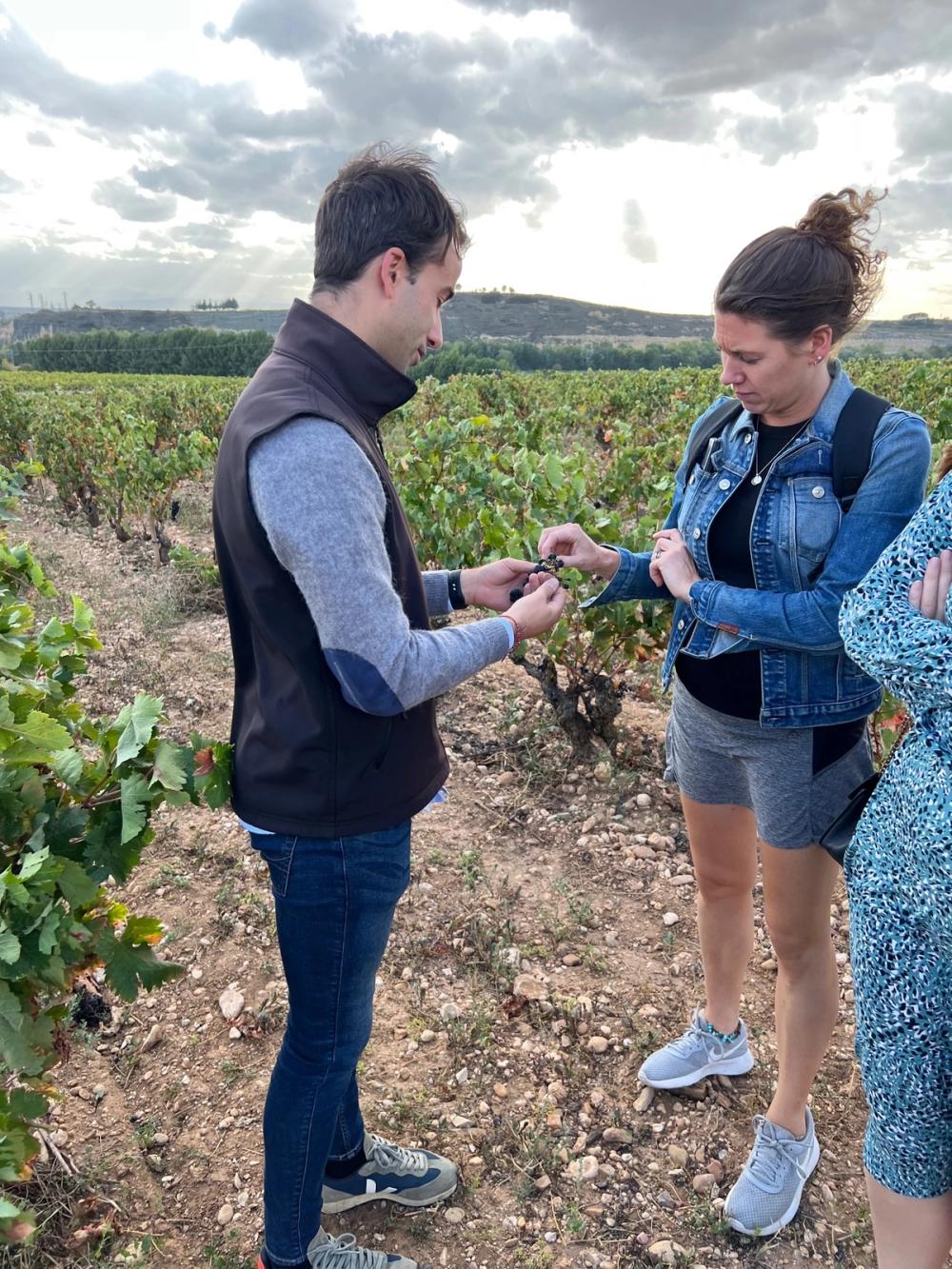
Juliet Doughty enjoying an impromptu grape tasting at Bodegas Bilbaínas
What perceptions of Rioja did you have before the trip?
Having been to Rioja before, I have always thought it quite a barren place. Lots of sandy, red dry colours and quite raw. It’s a region I have seen and have an image in my head of, but one I feel i have never really taken time to learn and understand the intricacies of. This is what I really gained from this trip, understanding the different sides, the slight rivalry of the Alavesa and Alta. The Consejo Regulador. I feel like we really got to understand the people and he culture, their feelings and emotions on the whole area.
What was your Rioja range before the trip?
We were selling one. Tondonia at £110.
What are your big takeaways from having been on the trip?
Understanding the region on a more personal level. I loved being taken to parts of the region where you could really see and understand the way the River Ebro divides the region. The altitude. Being taken up by Ostatu to the highest point and looking over the whole area. Going to Quel on the first day and understanding the history of that part of the region.
Getting to know the white wines better and how textured and well balanced a lot of them were. Also the new rules and how they are being used.
Which styles do you think are best suited to the premium UK on-trade?
I think both traditional and the more modern approach to Rioja both have an important place in the UK market. I think for my list too. There is definitely an ‘old school’ thought of what Rioja should be and is, but I think a juicy, fruit forward, less oaky approach to the wine is also very important to appear on wine lists and in restaurants and retail too.
In terms of the new and old regulations, I think i will take time for the UK to move away from associating quality with Reserva, Gran Reserva etc.
What do you think of the new regulations that now allow winemakers to make village, municipo or singular wines?
They are allowing terroir to become an important part of the region, which can never be a bad thing. I think in time, once the rules settle and people learn how to work with them it will allow Rioja to be taken more seriously and will allow producers to showcase their region to a new level. It may also mean further down the line they can charge more for their wines.
I think the UK market may get slightly confused by them. I think also Rioja should be careful to not loose the Crianza, Reserva and Gran Reserva, as this is what a lot of the UK market looks for in regards to quality.
But overall it is allowing Rioja to be more identifiable by specific places, soil types, altitudes and will hopefully bring more diversity to the region and, in turn, its wines.
What advice would you give a producer looking to get into the UK – first when choosing a distributor and secondly when looking to get a listing in your restaurant?
Find a supplier that suits your brand and production including things like volume and quality and most importantly style. Do trips to the UK and spend time with the supplier, not for events like London Wine Fair, but smaller more intimate trips. Host wine dinners in our restaurants and get your face and wine into as many restaurants as possible so that sommeliers can see you and speak to you, and learn about your story and wines.
Since the trip I have brought on two of the wines we tasted: Escondite del Ardacho – El Abundillano and Manzanos Gran Reserva. Two very contrasting styles and expressions of Rioja.
Ian Wharton, head sommelier, Scott’s Richmond
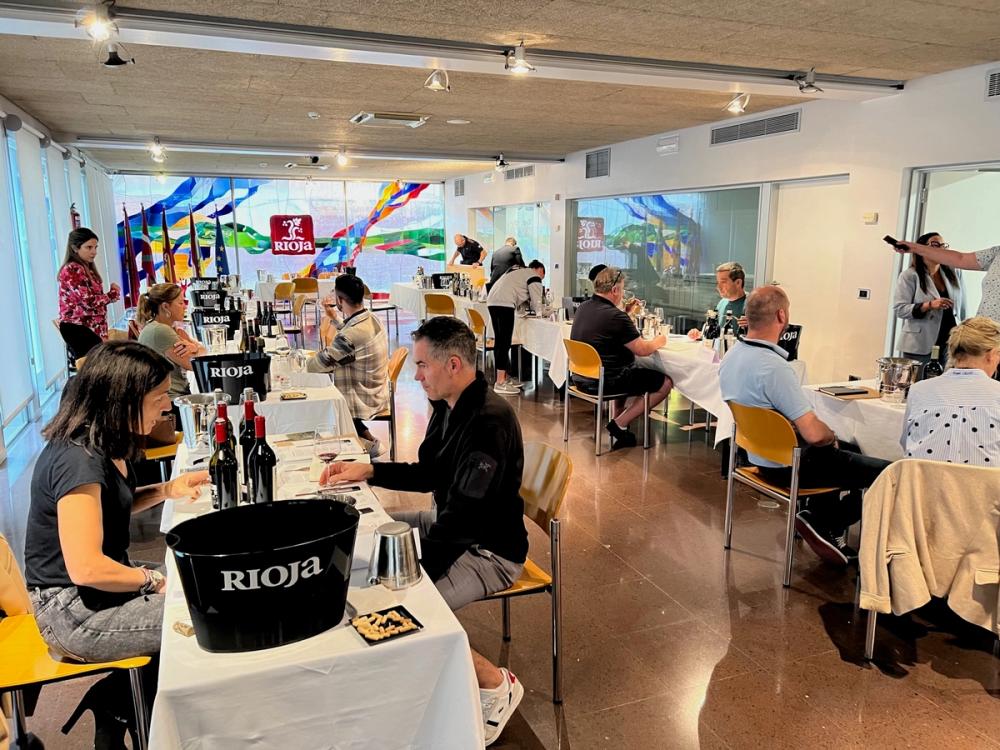
Ian Wharton, front left, during the producer tasting session hosted by the Consejo
What perceptions of Rioja did you have before the trip?
I had been to Rioja the previous year so had a good grasp on the region. I feel like it’s an under appreciated region that still offers great value. I think in my head, there were more producers in the ‘traditional’ camp.
What was your Rioja range before the trip?
We are focused more at the value end with El Coto Rioja Blanco and Bodegas LAN D12 Crianza. I have listed La Rioja Alta Alberdi and Ardanza before as well.
What are your big takeaways from having been on the trip?
There is a great history in the region of growers selling to larger producers. Many of these growers have now established their own wineries and are generally producing a more modern style of Rioja with less American oak. There is interest in championing traditional local varieties. Also, it’s nice to see large foreign investment like Rothschild bringing more international exposure to the region.
What surprised you most?
How many of the wineries we visited that I had never heard of and they produced significant if not huge quantities of great quality wine.
Which styles do you think are best suited to the premium UK on-trade?
I still think the premium on-trade likes big polished styles of wine. Likely with French Oak like Remirez de Ganuza – Macan- Roda. Although I tasted some great Viura, I feel perhaps there is less of a market for premium whites.
What do you think of the new regulations that now allow winemakers to make village, municipo or singular wines?
Like so many other regions, Rioja seems to be trying to follow the Burgundian ideal of terroir-focused wines. With so many of these popping up that don’t clearly show significant differences in the glass, it’s more likely to confuse the average consumer. With that being said, it’s nice that producers have an alternative to the old Crianza, Reserva, Gran Reserva model.
What would you like to see more from Rioja to help you in your role as a sommelier?
An online course that outlines the new regulatory changes.
What advice would you give a producer looking to get into the UK?
Choose a distributor that is in line with your philosophy and style. This will help get your wines to your target audience. Ask a few sommeliers where they think your wines fit in the market. So if you are making natural and funky wines look at Les Caves de Pyrene or Keeling and Andrew type importers. If you are a big box, classic producer then Liberty or Justerini & Brooks.
I’m looking for great wines with market appeal. Price is important, but secondary if I truly believe in the product. Label and packaging do slightly affect my decision as well.
I’ve listed two additional wines from Rioja since the trip: Finca Allende Rioja Blanco; and Palacios Remondo La Montesa,
Victoria Sharples

Victoria Sharples was made to feel at home at Marques de Riscal
What perceptions of Rioja did you have before the trip?
Perceptions were of two distinct camps. The traditional, heavily (often American) oaked wines that dominate supermarkets shelves, and the Rioja that I know from importing to Australia – ie refined Tempranillos with judicious use of French oak.
What are your big takeaways from having been on the trip?
There is a significant and conscious effort to create expressive, terroir-driven wines, with an emphasis on the vineyard and a reduction in reliance on traditional nomenclature of Crianza, Reserva etc.
What surprised you the most?
Significant innovation in vineyards and wineries. Massive push towards concrete, eggs and larger format more neutral oak (hooray). Seems to be great cohesion and cooperation between many wineries; an approach that would not be out of place in Yarra Valley. Very different to the culture of other ‘iconic’ regions such as the recently visited Chianti Classico.
Which styles do you think are best suited to the premium UK on-trade?
Less oaky, less alcoholic, fresher styles. Tempranillo seemed to have a ‘bad rap’ but actually elegant, fresher Tempranillo, temp blends and whites have immense potential and suitability for the premium UK on-trade
What do you think of the new regulations that now allow winemakers to make village, municipo or singular wines?
Definitely a proactive and valuable step, however, there seems to be a lack of cohesion amongst some wineries as to exactly what to do with the new regulations.
What would you like to see more from Rioja to help you in your role as a sommelier?
Maps! Less talk about Reserva, Crianza, and the mass market ‘opinion’ of Rioja and more focus on innovation, community, soils, varietals and the small batch of smaller scale, family-owned winery story.
What advice would you give a producer looking to get into the UK?
Look for a distributor that resonates and has wines in their portfolio that you like. Moreover, spend time with the sales team, make sure they are passionate and knowledgeable about wine. Make sure your wines sit alongside and complement the rest of the portfolio. See where the current wines are listed and if these are the sort of places your wines should be.
Will Clarke, assistant sommelier, The Pig Hotel

Will Clarke was impressed by the overall quality and diversity of the wines he tasted and has particular hopes for white Rioja
What perceptions of Rioja did you have before and after the trip?
My previous perceptions were pretty minimal and I assumed it was all based around heavy styles of red wine, traditional winemaking techniques from previous years and not really adjusting to the modern day life.
However, it is so much more than that. Beautifully hand crafted white wines are slowly becoming the ‘new-norm’, and as far as the red wines go, they are still in keeping with the traditional styles, but also broadening their horizons and trying new modern styles alongside adjusting to some new rules and regulations for the DOC itself.
What was your Rioja range before the trip?
Our entry level Rioja is at a very reasonable £62, and then we go from there right up to around £300 for some premium vintage Rioja’s including a rare white from Vina Tondonia. Following the trip, i have contacted a few of our suppliers hoping to get a few wines on the list from the producers we met on the trip.
What are your big takeaways from having been on the trip?
Getting to know the European culture a lot more. Just by heading to the local streets of Logrono at the end of the day – the streets were alive with fresh tapas being served through the windows and glass of wine being poured one after the other. Fantastic. Something i could get used to very easily.
What surprised you the most?
What surprised me the most was actually Marqués de Riscal Marquez. The sheer size of the estate and production scale was phenomenal – 7 millions bottles a year and it is still able to keep the same quality in every single bottle. Outstanding work.
Which styles do you think are best suited to the premium UK on-trade?
The Reservas, both red and white, due to the ageing periods they’ve had before release. A bit of bottle age appeals to customers a lot more. The younger wines tend to be a bit too powerful to start with. The other style I think suits is white Rioja. There’s just something about the use of Viura Malvasia that creates such an elegant wine, whether it’s been influenced by oak barrels or not. It think there’s a bottle, or style for everyone.
What do you think of the new regulations that now allow winemakers to make village, municipo or singular wines?
Initially slightly confusing, but it’s a better way to understand the true origin of the wine and a way to understand the story and terroir within the wine.
What advice would you give a producer looking to get into the UK?
I would recommend shopping around first and get a feel for the types of restaurants and businesses the distributors supply the wines to. That way they can understand the sort of customers their wines are going to and can target a particular style and audience.
I am personally looking for wines that have quality assurance, good ageing potential and have already established bottle age on the wine list – something that we know, as a wine professional, is what people want.
Paul Belcher, owner The Tapas Rooms
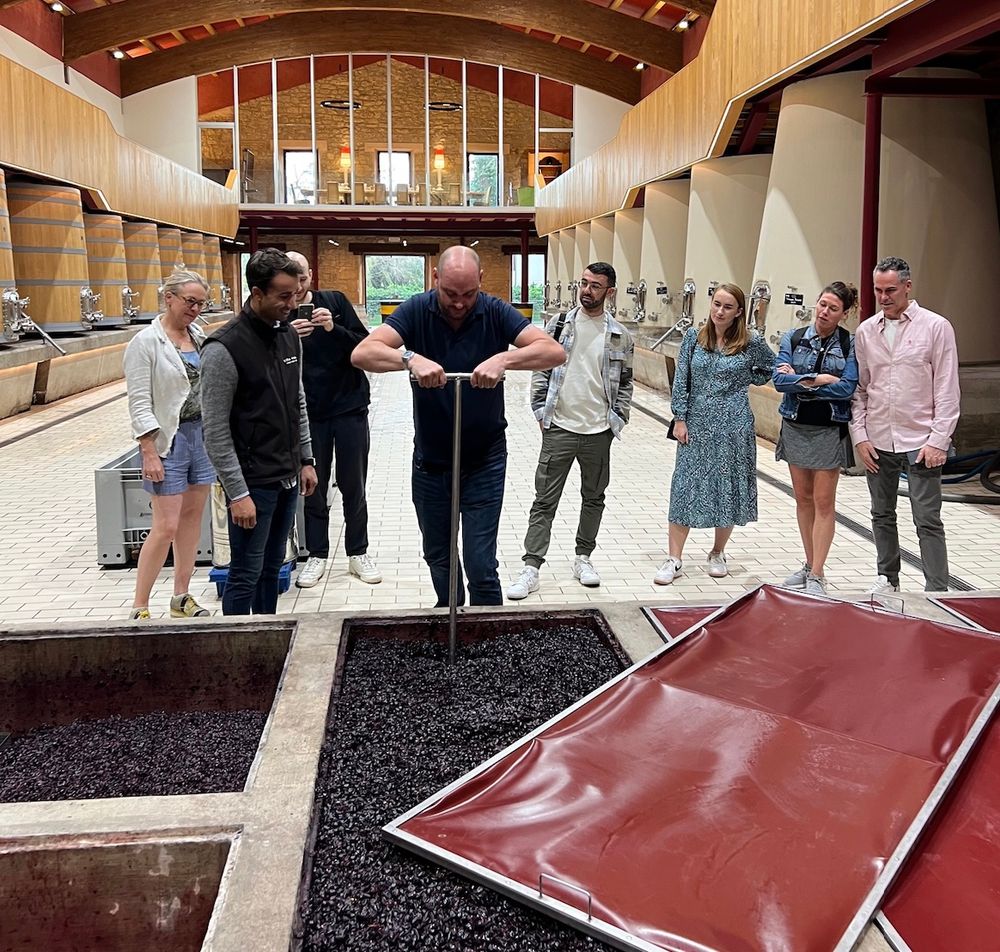
Paul Belcher doing his best to work the grapes at Bodegas Bilbaínas
What perceptions of Rioja did you have before the trip?
I perceived Rioja as a very classic region with strict rules around its wine making.
What styles of Rioja and price points were on your list before the trip?
We have a white, red (Jovan) and rosé Rioja on our glass list at around £30 a bottle, £8 a glass, we also stock higher end Rioja between £40 – £70.
What are your big takeaways from having been on the trip?
I enjoyed the massive difference between wineries especially in size but also in ethos & styles. I enjoyed the new Viñedos Singulares which give Rioja a Grand Cru type of recognition.
Which styles do you think are best suited to the premium UK on-trade?
I feel young fresh Riojas are still the most suited to us, especially the white Riojas and rosé. Withreds you have more scope as people are used to the rules of Crianza, Reserva etc.
What do you think of the new regulations that now allow winemakers to make village, municipo or singular wines?
The ability to make wines that reflect your best plot, terroir, or village can only help make wineries more individual.
What would you like to see more from Rioja to help you in your role as a sommelier?
We are not equipped to explain the new rules to customers yet so a more simpler guide to these changes would be great.
What advice would you give a producer looking to get into the UK?
Size is important. If you are too small you won’t have the reach and if you are too big you will be just a line in a catalogue. We look at price, but can we sell it? It’s easier to sell a wine with a story, or unique character.
Rioja by numbers
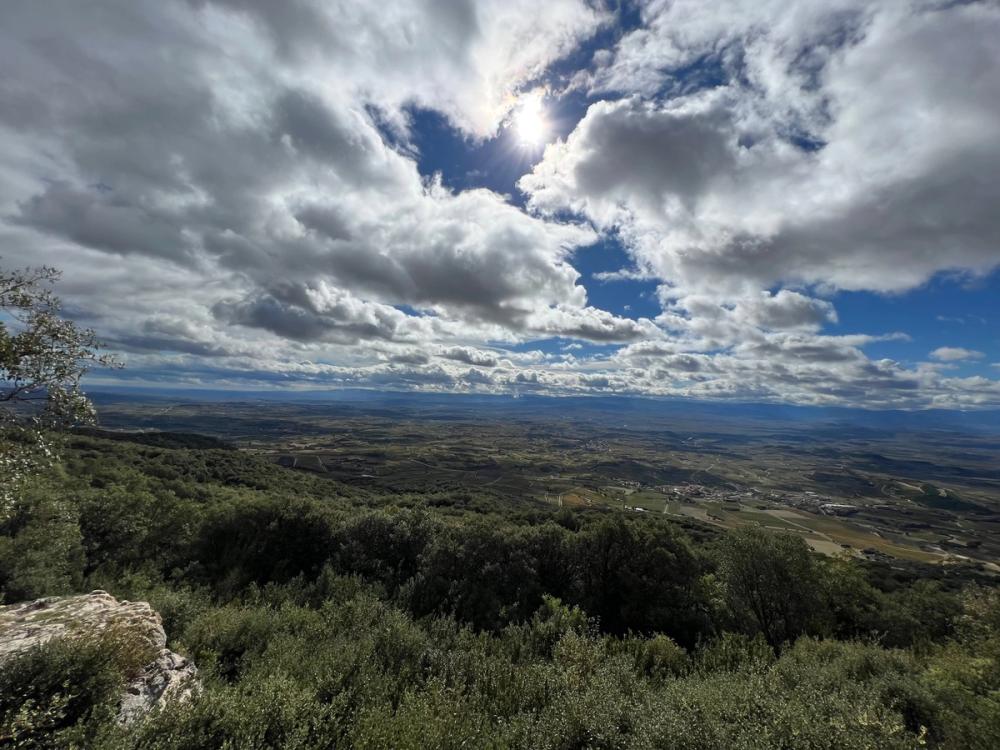
Rioja might be known as one big wine region, but it is very much the sum of its parts
Here are the last official figures released in 2022
Number of hectares: 66,797 split across:
Rioja Alta: 28,05 hectares
Rioja Oriental: 24,402 hectares
Rioja Alavesa: 13,344 hectares
14 authorised grape varieties
Registered municipalities: 144 of which118 are in La Rioja, 18 Alava and 8 Navarra.
742 wineries
132 unique vineyards
343m bottles produced in 2022
285,954,609 litres of wine from 2022 harvest
Total sales down 1.2% on 2021.
Exports down 3.11% in volume and 1.4% in value.
40% of wine sold in exports across 136 countries.
Other wineries tasted
The sommelier panel also had the chance to taste wines and meet representatives from a number of other producers also keen to share their experiences of the new Rioja. These included:
Valenciso(Boutinot)
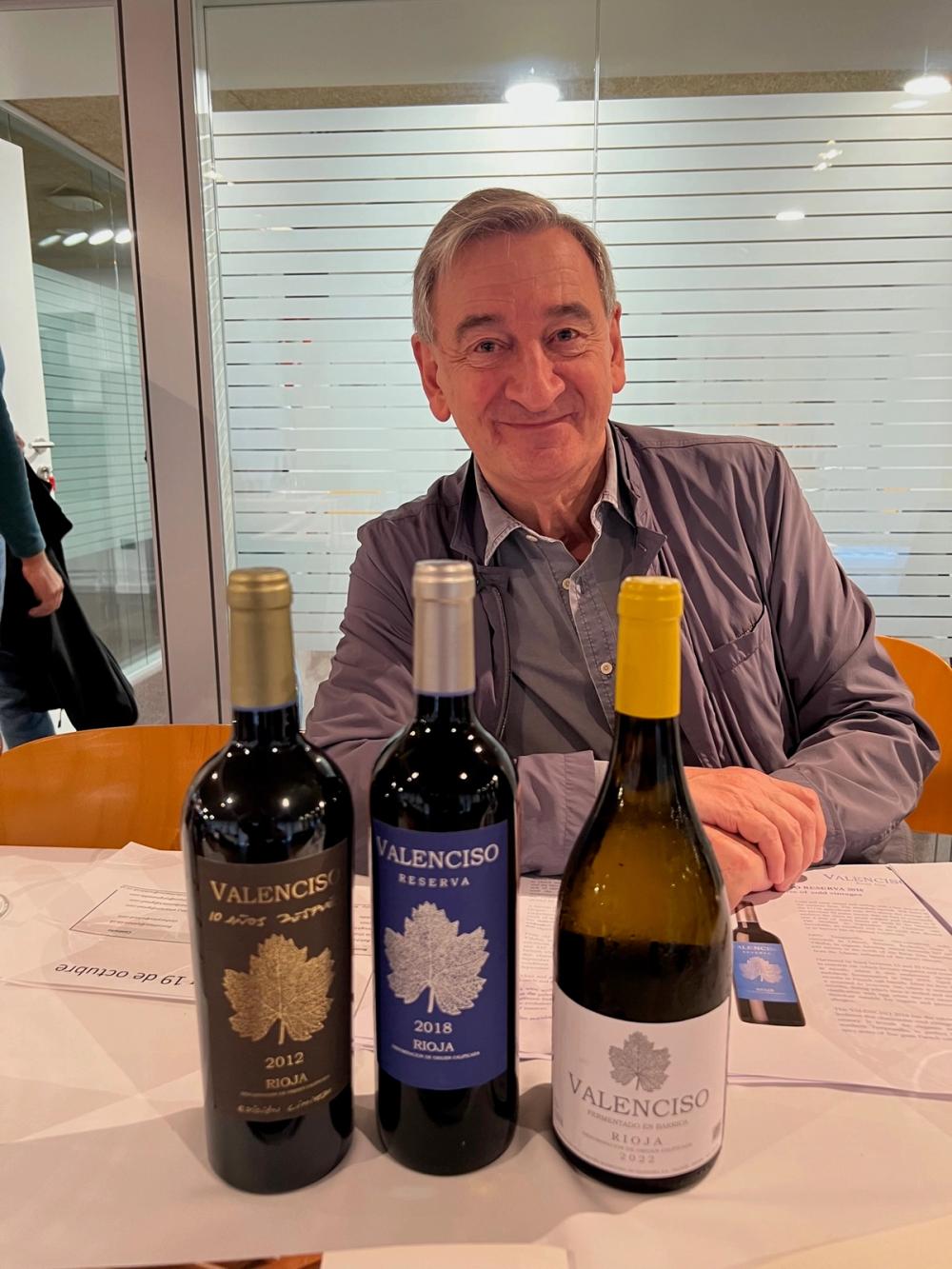
Luis Valentin and his range of organic wines at Valenciso
Luis Valentín and Carmen Enciso joined forces in 1998 to set up this non-certified organic winery which produces up to 150,000 bottles a year from grapes sourced from 29 hectares across mainly Rioja Alta, 90% of which it owns. It has worked hard to reduce production to 5,000 kilos per hectare to improve the quality of its grapes and has introduced concrete tanks to help finesse and soften its wines.
Bodegas Manzanos(Alliance Wine)
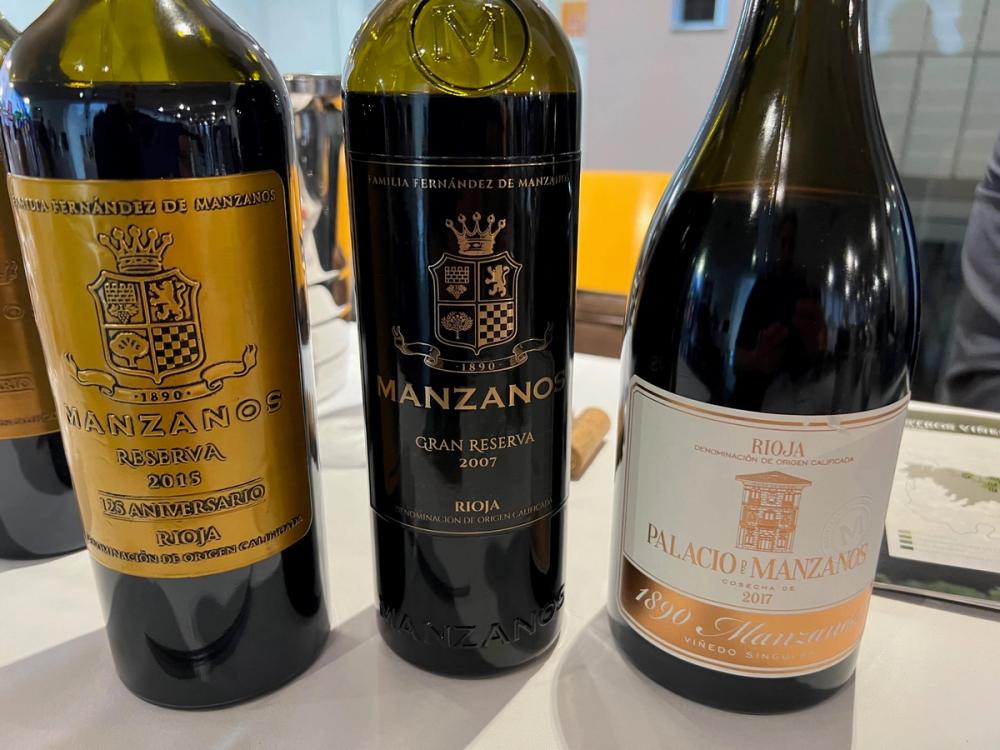
Bodegas Manzanos has been making wine since 1890 and has been run by the fifth generation of the Manzanos family since 2010. It has 950 hectares of vineyards across different regions of Rioja, of which it owns 250 and manages the rest. It has a further 50 hectares in Navarra and controls 525 hectares more. In Rioja it grows Tempranillo, Garnacha, Graciano and Mazuelo red grape varieties and white grapes, Viura and Chardonnay.
Palacios Remondo (Bancroft Wines, Berry Bros & Rudd)
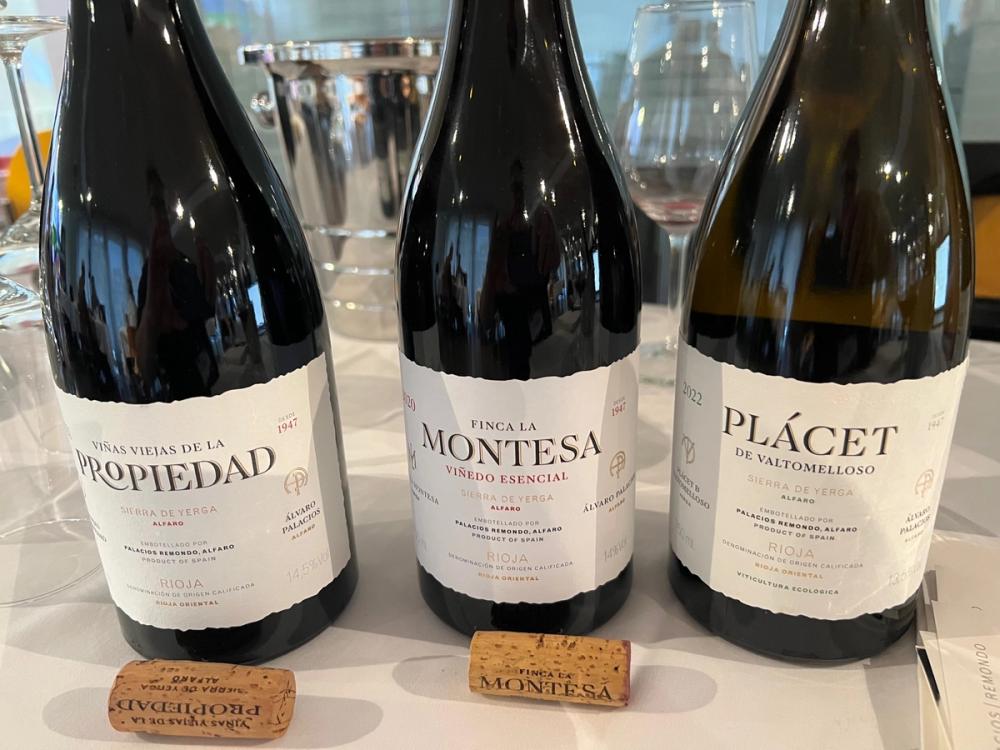
Family-owned Palacios Remondo is based in Alfaro, in the high altitude slopes of Rioja Oriental, and acclaimed winemaker Álvaro Palacios is keen to champion Garnacha from the area, particularly from old bush vines. The organically-farmed La Montesa vineyard on the hillsides of Monte Yerga helps to produce fragrant aromatically-intense wines. Palacios Remondo also produces an elegant white wine Plácet Rioja Blanco from Viura, fermented and aged in large old foudres.
Bodegas Lan (Liberty Wines)

Bodegas Lan is named from the three provinces that make up the D.O.Ca. Rioja: Logroño (now La Rioja), Álava and Navarra. It works mostly with Tempranillo, Mazuelo, Graciano and Garnacha vines aged between 40 and 60 years of age. Here the emphasis is on careful ageing with specific wines matched to either French, American, Russian, Hungarian, Pyrenean oak and hybrid barrels.
Bodegas Bhilar(Bibendum)
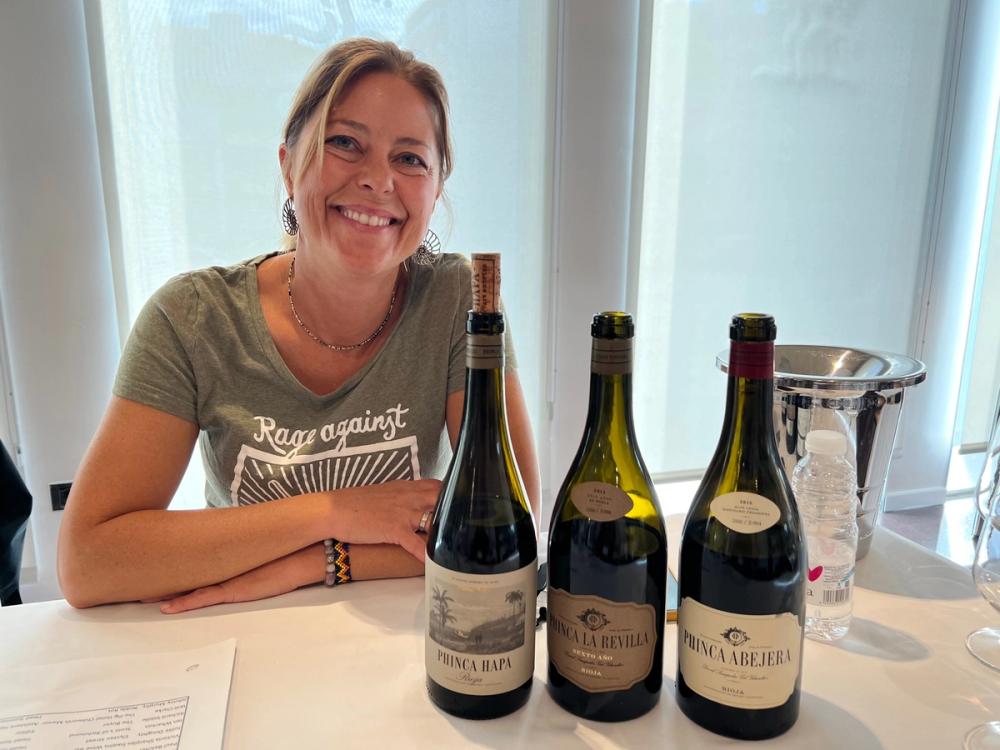
Melanie Hickman was able to show the off beat, off piste wines she and her husband David Sampedro are making at Bodegas Bhilar
A great example of the anything goes mentality in the new Rioja. This is a small winery in Rioja Alavesa run by husband and wife team, David Sampedro and Melanie Hickman, it produces around 80,000 bottles a year from a vineyard planted in 1967 at 650m with chalky, limestone soils with a split production between red and whites. Organic since 1999 it also following biodynamic principles and even claims to be off grid since 2015 relying on solar power and plough horses in order to make terroir specific wines from indigenous grape varieties and low intervention winemaking.
Bodegas Baigorri(Matthew Clark, Inverarity Morton)

A stunning looking high-tech, gravity-driven, five-level winery which digs deep well below the surface in Rioja Alavesa. It claims to be the first winery in Spain to be classified Sustainable Fair’n Green. It sources mainly indigenous grapes from bush vines, including 32 of its own hectares and 100 hectares from growers within 10km of the winery. It uses minimum intervention winemaking to produce elegant, quality wines ideal for ageing. Total production is 500,000 bottles.
Finca Valpiedra(Berkmann, Direct Wines)

Finca Valpiedra is one of five wineries owned by Familia Martínez Bujanda, three of which are in Rioja – Finca Valpiedra, Cosecheros y Criadores and Viña Bujanda – which also has facilities in La Mancha and Rueda. Finca Valpiedra owns a single 80 hectare vineyard and produces four wines exclusively from that vineyard. A terroir to bottle concept. 250,000 bottles on average. It enjoys a beneficial microclimate that is half-Mediterranean (warm summers) and half-Atlantic (cold winters). It grows indigenous varieties including Tempranillo, Graciano, Maturana Tinta, Viura.

Family business based in Rioja Alta it produces around 650,000 bottles a year from a range of 20 wines, with both commercial and varietal wines. It owns 98 hectares and manages a further 35 and enjoys Continental and Mediterranean climates with considerable temperature differences between day and night. It produces mainly indigenous varieties including Tempranillo, Viura, Garnacha, Graciano and Mazuelo.
Bodegas Bideona (Hallgarten & Novum Wines)
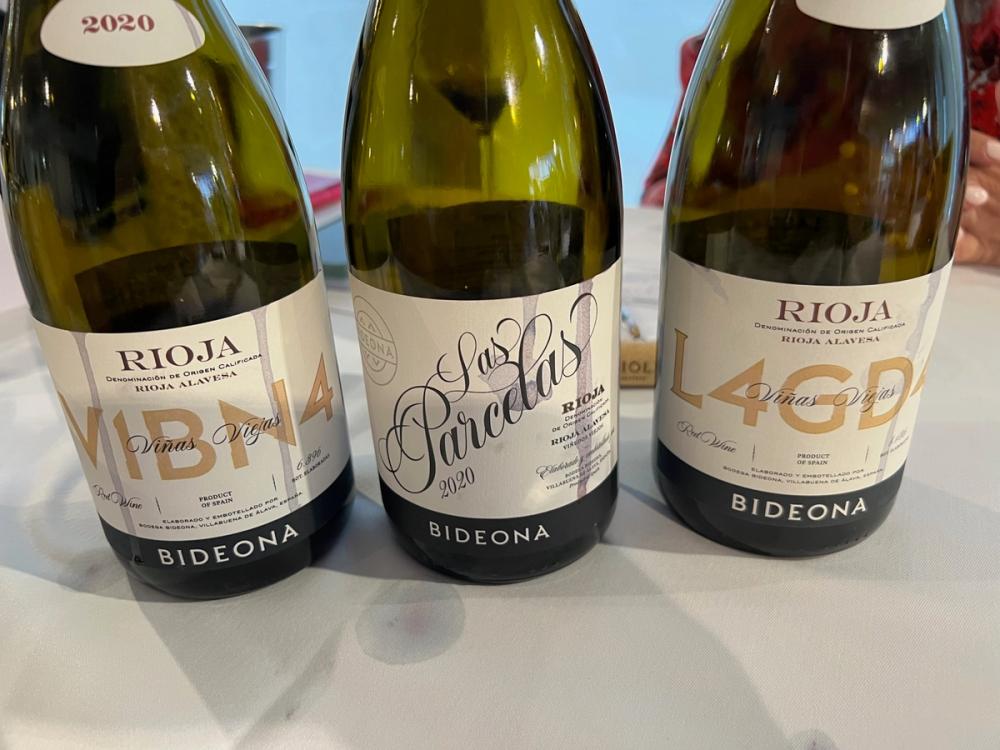
Situated in Rioja Alavesa Bodegas Bideona puts its terroir at the heart of everything it does, captured in its village wine L4GD4. It wants to stand out and be different and even uses its own code on its labels to differentiate the “freedom” in what it does and to make the most of new wave winemaking in Rioja. It works with up to 300 different parcels of grapes taken from across its vineyards to reflect its diversity and produces single vineyards, village and regional wines.
Bodegas Luis Alegre(seeking distribution)
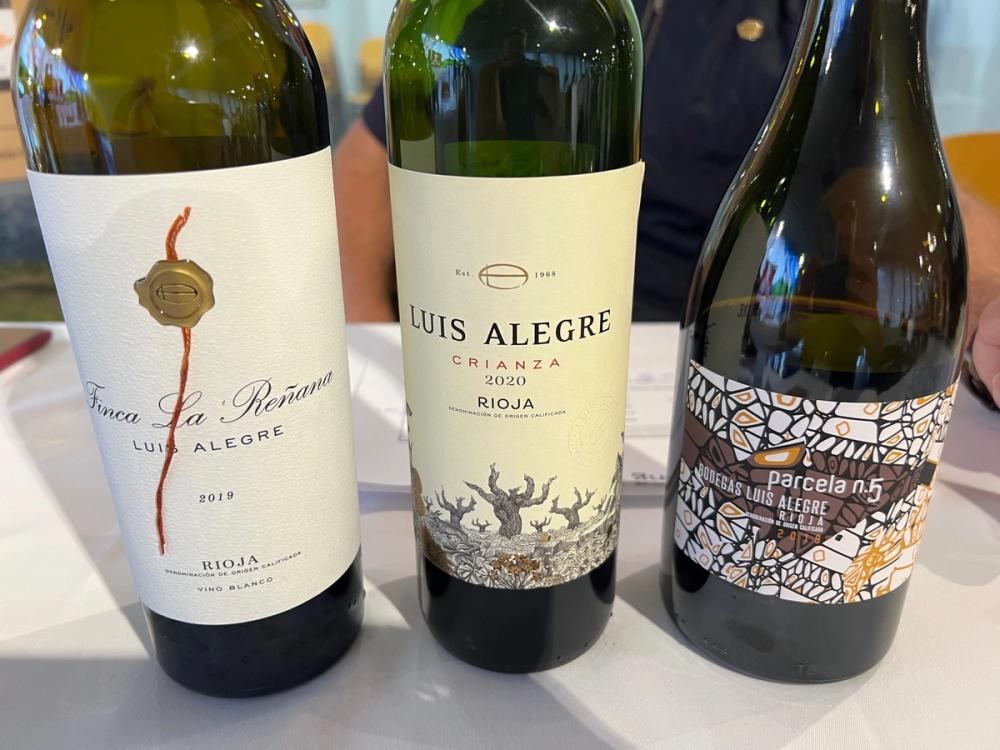
Also in Rioja Alavesa Luis Alegre, that was formed in 1968, is producing 300,000 bottles a year from its fully-owned vineyards in Laguardia. It looks to make terroir specific wines with, for example, its Finca Portiles, Finca La Reñana, and Parcela Nº5, all Tempranillo-based wines, but from very different parcels of soils to give them their own personality. The winery specialises in barrels and ageing.
Tentenublo (Lea & Sandeman)

Roberto Olivan is getting a lot of attention for his cutting edge wines
Roberto Olivan is one of the exciting, cutting edge winemakers in Rioja who has developed his own winery based on 15 hectares in Rioja Alavesa that is broken down into 40 plots to allow him to make truly site specific wines. He specialises in making field blend wines with a number of local varieties, using whole bunch ferments to make bright, fresh, juicy, vibrant wines.
- If you want to find out more about Rioja and its wines go to the Consejo website here.

































